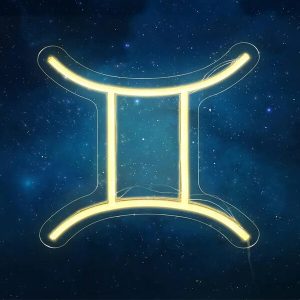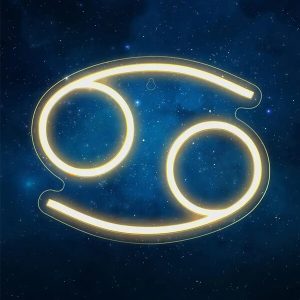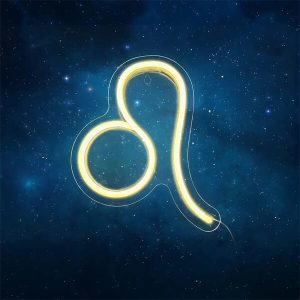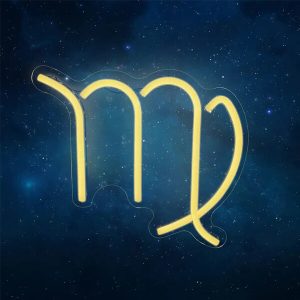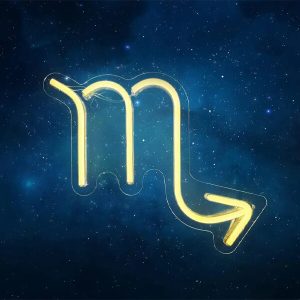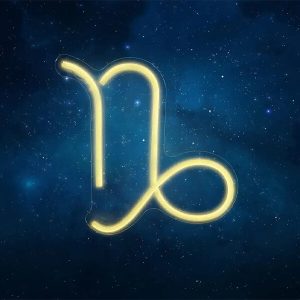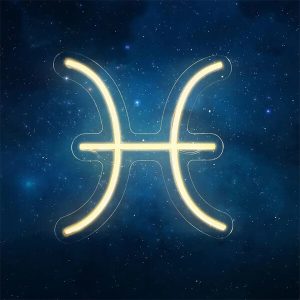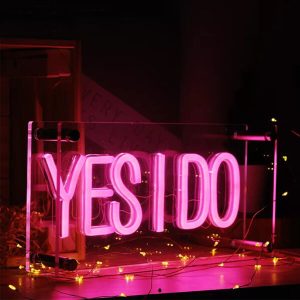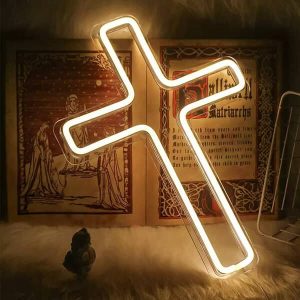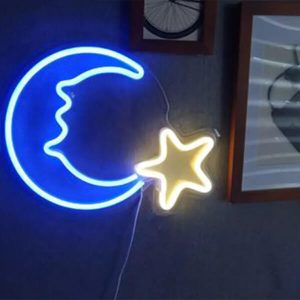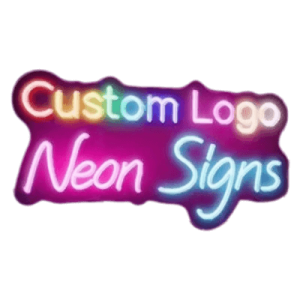Zodiac Neon Signs
— Illuminate Your Zodiac Sign with Customizable Neon Signs – Captivating Décor for Astrology Lovers
Transform your space into an idiosyncratic and emblematic sanctuary by illuminating your zodiac sign with fashionable and tailored customizable neon signs that manifest your astrological identity. This celestial ambiance will undeniably enhance the aesthetic appeal of your surroundings and is especially suitable for ardent astrology enthusiasts. Procure yours without delay!
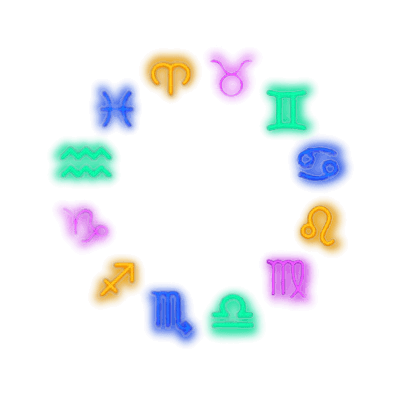
Zodiac Neon Signs Product Description
Introducing the Zodiac Neon Signs, which are customizable and mesmerizing. These signs have the ability to illuminate any space with celestial charm, while also allowing you to express your astrological identity in a unique and stylish manner.
The Zodiac Neon Signs are crafted with the highest quality LED lights, ensuring that they are energy-efficient, durable, and safe to use. In addition to their practical functionality, they also boast a sleek and modern design that can add a captivating touch to any room or business space. The soft and warm glow of the neon lights creates a mesmerizing ambiance, which can elevate your décor to a whole new level.
Our Zodiac Neon Signs possess a distinctive quality that can be tailored to suit one’s preferences. The customizable feature enables one to select their zodiac sign, which facilitates the creation of a unique neon sign that reflects their cosmic persona. The LED Neon Signs have the ability to illuminate one’s zodiac in a personalized way, whether that be a fiery Aries, an earthy Taurus, an airy Gemini, or any other zodiac sign.
Easy installation options are available for our Zodiac Neon Signs, including wall mounting or tabletop display. The aforementioned product boasts a remote control which confers users with the capacity to customize the brightness, dimness, and flashing configurations in line with their predilections. It serves as an ideal choice for personal use, as a gift for astrology enthusiasts, or as a statement item in a business or event space.
Expressing one’s adoration for the study of celestial bodies and showcasing one’s cosmic essence can be accomplished through the acquisition of our remarkable Zodiac Neon Signs. These signs have the ability to illuminate one’s specific zodiacal constellation, thereby creating a captivating and profound statement within any given space. Do not hesitate to place your order now and elevate your decor to celestial heights!
Customizable Zodiac Neon Signs – Express Your Astrological Identity
The Zodiac neon signs are an exceptional and artistic manifestation of the twelve astrological signs within the Zodiac. The common manifestation of these indications often entail the depiction of symbols or glyphs that are interrelated with every individual Zodiac sign, which encompasses the ram for Aries, the bull for Taurus, the twins for Gemini, and other similar representations. These symbols are crafted with the use of neon lights that emit a bright and colorful glow. The neon lights are frequently installed on a clear or colored acrylic backing, which contributes to the visual appeal and generates an impressive visual impact.
The Zodiac is a circular pattern consisting of twelve astrological signs that are utilized in Western astrology to depict various time periods throughout the year. Each sign is associated with particular personality traits, behaviors, and destinies.
The twelve zodiac signs are as follows:
- Aries (March 21 – April 19)
- Taurus (April 20 – May 20)
- Gemini (May 21 – June 20)
- Cancer (June 21 – July 22)
- Leo (July 23 – August 22)
- Virgo (August 23 – September 22)
- Libra (September 23 – October 22)
- Scorpio (October 23 – November 21)
- Sagittarius (November 22 – December 21)
- Capricorn (December 22 – January 19)
- Aquarius (January 20 – February 18)
- Pisces (February 19 – March 20)
The employment of the zodiac in astrology is intended to furnish introspection and explication regarding an individual’s personality traits, conducts, and fates, which are contingent on their date of birth and the solar alignment at that juncture. Several individuals subscribe to astrology and unearth significance in their zodiac symbol, utilizing it as a barometer for self-awareness, comprehending connections, and determining courses of action in their existence. Additionally, the zodiac is frequently employed for embellishing and emblematic purposes in diverse forms of art, jewelry, and home decoration.
The origination of the astrological system can be attributed to the earliest human civilizations, who assigned great significance to methodically analyzing the heavenly entities, including the sun, moon, and constellations, as a crucial constituent of their communal and spiritual convictions. The zodiac that is currently familiar to us can be traced back to the ancient Mesopotamian civilization, where the notion of dividing the dome of the heavens into twelve commensurable segments, each signifying a specific temporal epoch, came into existence roughly five millennia ago.
The Babylonians, an esteemed Mesopotamian civilization distinguished for their astute innovations, were pioneers in the establishment of an astrological framework that was firmly entrenched in the scrupulous scrutiny of celestial phenomena. They subscribed to the notion that celestial bodies, particularly the sun and moon, wielded significant sway over both human occurrences and natural phenomena on Earth. To this end, they delineated the firmament into twelve equivalent parts, which corresponded to the twelve lunar months in a year, and allocated each segment to a particular constellation or star cluster. This system, in due course, formed the bedrock for the zodiac signs that are now commonplace.
The notion of the zodiac underwent further development by the ancient Greeks, who embraced the Babylonian system and bestowed the appellation of twelve sections upon diverse animals and mythological creatures. The moniker “zodiac” itself emanates from the Greek term “zodiakos,” signifying “circle of animals.” The Greeks also appended the notion of the ecliptic, the visible path of the sun across the firmament, as the foundation for the zodiac symbols.
Over time, sundry cultures and civilizations worldwide have integrated their own interpretations and convictions into the zodiac, giving rise to numerous regional variants and cultural influences. Nonetheless, the fundamental concept of the zodiac as a circle of twelve astrological signs associated with particular time periods and personality traits has persisted across diverse cultures and is extensively implemented in Western astrology in the present day.
The burgeoning fascination with astrology and zodiacal manifestations has yielded a surge in popularity for zodiac neon signs, serving not only as a tool for commercial enterprises but also as a means for personal expression through home decor and gift-giving. Our selection of zodiac neon signs is abundant in diverse and unique designs, sizes, and customizable options, enabling individuals to showcase their zodiac sign with a sense of pride and imbue their environments with a touch of cosmic allure.
Why Choose Us
Quanzhou BgNeon Industrial Co., Ltd. is one of the largest manufacturers and exporters of LED neon signs in China. Our enterprise is dedicated to the creation, advancement, and manufacturing of LED neon signs. Our merchandise boasts of superior quality, economical pricing, quick turnaround time, energy efficiency, and eco-friendliness. Furthermore, we do not impose any minimum order requirements and are capable of producing a customized set for your specific needs.

Professional Team
With over 10 years of experience in the LED neon sign industry, it’s no surprise that our entire team is highly skilled and talented. Learn more

No Minimum Order Quantity
BgNeon is flexible in production and can meet your needs for ordering different quantities. We can even customize a set for you.

Strict Quality Control
We have a strict quality control process to ensure that the neon signs delivered to our customers are flawless. Learn more

Customization Capability
Our professional designer offers you the best advice, making your sgn always the best for your market, it will give you a strong edge over your competitors. OEM & ODM orders are welcomed. Learn more

Fast Lead Time
Lead time is 2-3 working days, and we also provide comprehensive online technical support and customer service.

100% On-Time S&E Guarantee
We guarantee 100% on-time delivery. So far, we have never had a case of late delivery.

Factory Direct Pricing
We guarantee affordable prices and the highest quality among all manufacturers.

100% ECO Friendly
All of our LED neon signs are not harmful to the environment.

1-Year Warranty
Each product comes with an extraordinary 1-year warranty.
Frequently Asked Questions
Can I customize the zodiac sign in the neon sign?
Yes, our Neon Sign has the capability to be customized to meet your individualized preferences. The choice to designate your zodiac sign is offered, and we will fastidiously construct a unique neon sign that exhibits your astrological essence.
What are the dimensions of the Neon Sign?
The variability of the dimensions of our Neon Sign is contingent upon the particular design and zodiac sign that has been chosen. For precise dimension information, we respectfully request that you contact our customer support team.
How do I install the Neon Sign?
The procedure for installing our Neon Sign is a facile task that necessitates little exertion. The sign may be secured to the wall utilizing the mounting hardware that is provided in the package, or it may be presented gracefully on a tabletop using the optional acrylic stand. In order to satisfy the convenience of our highly regarded clientele, the merchandise is accompanied by comprehensive installation instructions that furnish detailed guidance on the setup process.
How is the Neon Sign powered?
The Neon Sign proffered herein is powered by a low-voltage transformer that is conveniently included with the product. Additionally, a conventional power cord that is suitable for interfacing with any standard electrical socket is provided as an accompaniment to the product.
Can I adjust the brightness and flashing mode of the neon sign?
Yes, one may opt to choose a remote that possesses the capacity to dim for their neon signage, thereby providing them with the opportunity to tailor the brightness, obscurity, and oscillation modes to correspond with their individual inclinations. Learn more
Is the Neon Signs safe to use?
Yes, our Neon Signs are crafted with great precision utilizing advanced LED lighting technology that exhibits exceptional energy efficiency and boasts a remarkable safety profile. The thermal characteristics of the neon lights are such that they maintain safe and prolonged usage by not producing excessive heat.
Is the Neon Signs suitable for outdoor use?
In the present investigation, a varied selection of neon signage is presented which can be classified into two distinct groupings: those specifically tailored for indoor settings and those intended for outdoor environments. The perceptive consumer is presented with the chance to meticulously assess their own unique circumstances and determine the most fitting sign for their necessities.
What is the warranty on the Neon Sign?
Our Neon Sign is furnished with a warranty that is in effect for a duration of one year. For a more comprehensive understanding of the scope and constraints of the warranty protection, we cordially urge you to communicate with our highly esteemed customer service squad.
Can I gift the Neon Sign to astrology lovers?
Undoubtedly, the Zodiac Neon Signs we offer provide an immaculate offering for those individuals who possess a profound proclivity toward astrology. These signs afford them the opportunity to exhibit their celestial disposition and imbue their environment with an atmosphere of celestial refinement.



